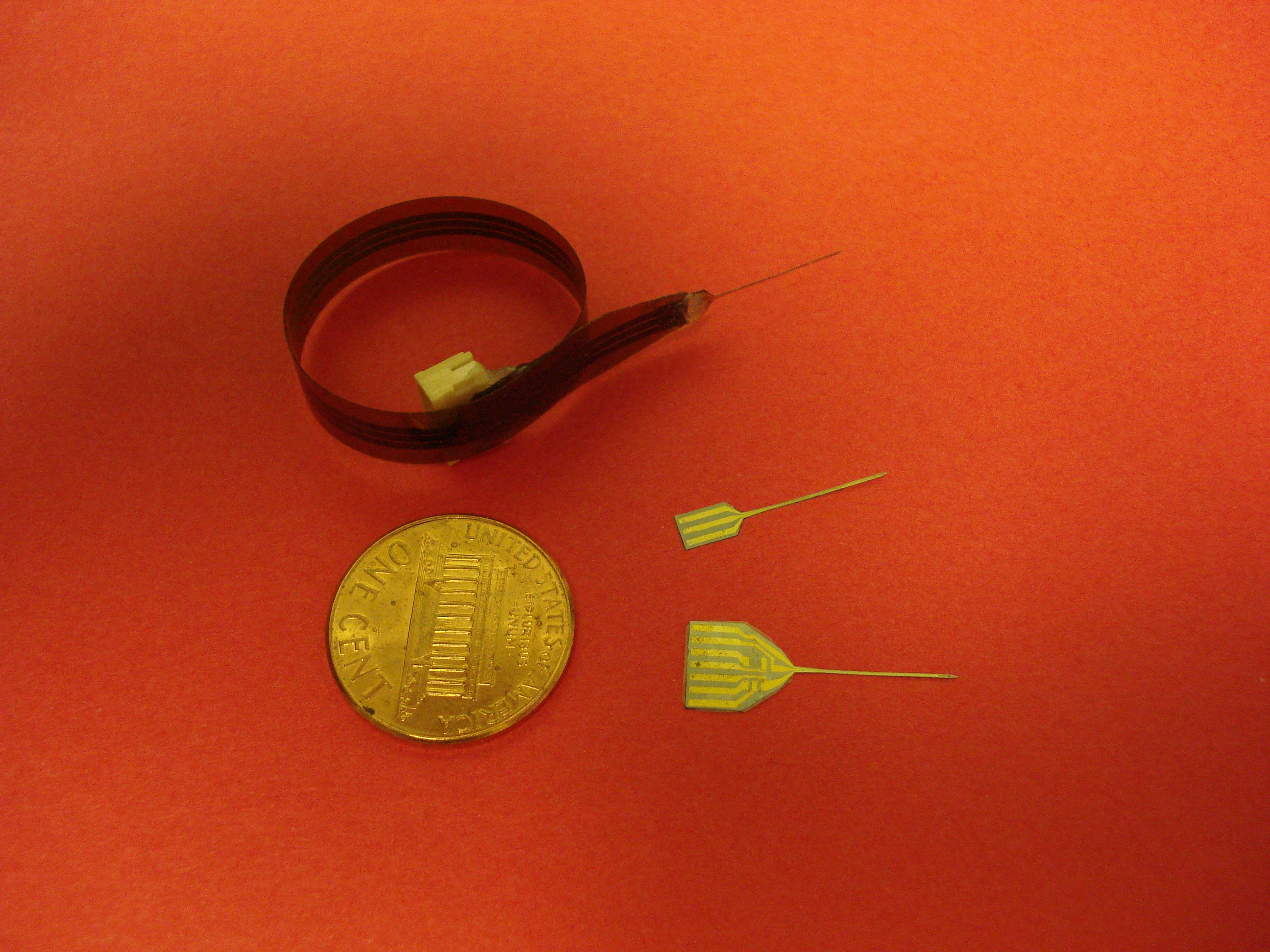Researchers Use Nanowires to Develop Neural Probe That Will Limit Damage to Cells and Biological Tissue
FAYETTEVILLE, Ark. – Engineering researchers at the University of Arkansas have developed a neural probe that demonstrates significantly greater electrical charge storage capacity than all other neural prosthetic devices. More charge storage capacity means the device can stimulate nerves and tissues with less damage and sense neural signals with better sensitivity.
|
|
|
|
|
|
The neural probe, made of gold and iridium oxide nanowires grown vertically on a polymer or titanium substrate, will improve the function and reliability of neural prosthetic devices. It has also displayed superior biocompatibility and mechanical strength compared to similar silicon structures.
“Our goal is to develop functional systems that can simultaneously stimulate nerves or muscle cells and record physiological changes in the human body,” said Hargsoon Yoon, research assistant professor in the College of Engineering and lead researcher on the project. “Our approach can minimize cell damage and even provide higher electrode efficiency than commonly used electrodes.”
Needle probes are used as neural prostheses to help improve quality of life for patients with severe impairments. Current clinical applications of neural prosthetics include cochlear and retinal implants, cardiac pacing and defibrillation, restoration of urinary bladder function, functional electrical stimulation in paralyzed individuals and deep brain stimulation for people with Parkinson’s disease and Tourette syndrome.
The research team, based at the university’s Center for Wireless Nano-, Bio- and Info-Tech Sensor and Systems, developed probes that integrate free-standing, “hetero-structured” nanowires. Hetero-structured means the nanowires have an inner core and outer layer. Made of gold, the inner-core nanowires were grown vertically on titanium and polymer substrates. The outer, functional layer, made of iridium oxide, provides charge storage capacity for neural signal sensing and stimulation.
Researchers repeatedly demonstrated an electrical storage capacity of 48.6 Coulombs per square centimeter. Units of electrical charge are measured in Coulombs. Working with different materials, other major research groups, including teams at Stanford University and University of Southern California, have developed probes with less than half the storage capacity of the University of Arkansas probe.
Because storage capacity is directly related to density of electrical current needed to stimulate nerves and muscle cells, the probe can transfer charge into biological cells and tissues using less voltage – and less battery power – and thus can operate longer with less tissue and cell damage.
“Electrodes with low-charge storage capacity require higher stimulating voltage levels,” Yoon said. “It is this higher voltage that can damage biological tissues and the electrode itself.”
Yoon collaborates with Vijay Varadan, distinguished professor of electrical engineering and director of the university’s High Density Electronics Center, to develop a system that will include nanowire electrodes, wireless communication and a power source for bio-packaging. The wireless network will facilitate closed-loop dynamic adjustments of the system and continuous monitoring of patients during stimulation.
Varadan holds the College of Engineering’s Twenty-First Century Endowed Chair in Nano- and Bio-Technologies and Medicine and the college’s Chair in Microelectronics and High Density Electronics. In addition to his position as director of the above center, he directs the university’s High Density Electronics Center. Varadan is also a professor of neurosurgery in the College of Medicine at the University of Arkansas for Medical Sciences in Little Rock, Ark.
The Center for Wireless Nano-, Bio- and Info-Tech Sensor and Systems is funded by a grant from the National Science Foundation.
Contacts
Hargsoon Yoon, research assistant professor, electrical engineering
College of Engineering
479-575-6092, hyoon@uark.edu
Vijay Varadan, distinguished professor, electrical engineering
College of Engineering
479-575-2873, vjvesm@uark.edu
Matt McGowan, science and research communications officer
University Relations
479-575-4246, dmcgowa@uark.edu
Headlines
Four Students Named Goldwater Scholars; Two Earn Udall Honorable Mentions
Four U of A students have received the prestigious Goldwater Scholarship, an award for top students in mathematics, science, and engineering.
Cross-Campus Collaboration Culminates in New Outdoor Geological Installation
Grand opening event to celebrate the new GeoLab installation at the U of A’s Gearhart Hall courtyard is set for May 3. The installation will be open to the public year-round.
First Students to Use Online Degree to Hone Nursing Leadership, Elevate Patient Care
Hanna Baxendale and Wendi Kimbrell will begin coursework in the Doctor of Nursing Practice-Executive Master of Business Administration program offered by the Eleanor Mann School of Nursing and Walton College.
Join the Office for Sustainability on a Final Cruise to Campus
Cruise to Campus Wednesdays have fostered a gathering space for individuals interested in biking to campus. Drop by the Old Main Lawn from 7:30-10 a.m. Wednesday for coffee, something to eat and conversation.
Fay Jones School Student Ambassador Program Gives Voice to Design Students
The student ambassador program at the Fay Jones School of Architecture and Design is built to connect top design students with their school, its alumni, its future students and others inside and outside the school.








